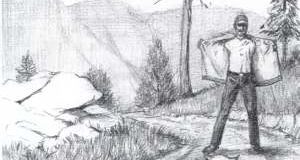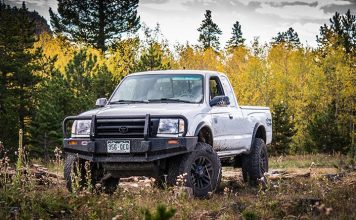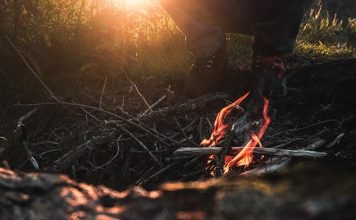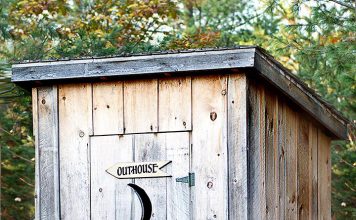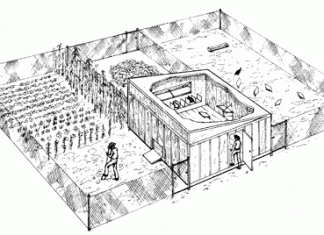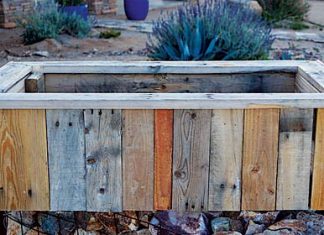 |
|
| Issue #16 • July/August, 1992 |
On May 5, 1989, tornadoes ripped through parts of three western North Carolina counties, including ours, and left piles of debris where houses, also including ours, once stood.

Almost 5000 square feet, this house, built from trees downed by a tornado, cost $20,000. The logs provide such insulation that the entire house is heated, even in the coldest weather, by a wood stove in the basement and, when needed, a fireplace in the den. Some of the rooms are 36 feet long and 18 feet wide.

To cut squared logs without special chain saw attachments, first use a square and level to mark off on both ends of the log the dimensions you want, and then snap a chalk line from one corner of the layout to the corresponding corner on the other end of the log.

Cut a guide grove along the chalked line, and then cut along the layout line and, keeping the bar straight, through the entire length of the log.

When the log is finished, pry up one end and rest it on chunks of unused logs. When the end is high enough, back the bed of a pickup truck under the end of the log in place, and pull it to the building site. Take care that you do not overload the truck suspension system or engine.

Logs for smaller expnases can be loaded into the bed of the truck and weighted on one end to keep them from shifting in transit.

To cut boards, square top and bottom of the log and them measure off the thickness of the desired board and cut as you did for the large logs. Finished results are very comparable to anything in the lumber yard. Use boards for flooring and wall covering.

Drill ¼ inch holes every 2 feet all the way through the top log. Then use a 5/8 inch bit to drill a cecond hole 5 inches deep. Drive a fluted spike into the hole and into the log below. Use a punch to countersink the spike halfway through the log.

Cut support posts to reinforce girders. Use a level to get perfect positioning of the support post.

Cut two-by-fours from smaller sections of logs and use these for railings. You can cut a superb two-by-four twelve feet long in about ten minutes at a cost of about twelve cents or less.
Our destroyed house was a restored 4,000 square foot pre- Civil War plantation house. And, like many other homeowners, we learned that the tornadoes were only the beginning of our problems.
Our insurance companies paid a grand total of $1,600 for the house, outbuildings, cars, and personal property. Federal, state, and local agencies’ help was minimal at best, and we quickly learned that if we were to have a home, we’d have to build it ourselves.
As a freelance writer, I learned that I could not collect any unemployment benefits (because I could not fire myself, I was told) despite the facts that I had not time, place, or equipment for my work. Everything was literally gone with the wind.
We had $15,000 in ready cash, and, armed only with a chain saw, determination, and desperation, we went to work. The tornado that leveled our house had also uprooted a huge stand of mature trees, including poplar, oak, hickory, and maple. It was in the tangle of trees that we started to build our house.
We told ourselves that we had always dreamed of owning a log house, and now was the perfect time to build one. My wife, Elizabeth, 47 years old and a former newspaper editor, our son, 13 years old and a middle school student, and I, 57, retired public school and college teacher and freelance writer, tackled the formidable task of dealing with the monstrous trees.
We soon realized that the tornadoes, even though destroying our home, also did us a sort of back-handed favor. They had laid the trees down without wrecking or twisting them so badly that they could not be used. We did not have the worry and danger of cutting down trees: a degree of consolation.
Our first task was to select the types of trees we wanted to use. Availability dictated that we’d use poplars for the walls. The trees were tall, straight, and easy to reach. We’d use hickory for support posts, oak for door and window framing, and pine for wall covering, ceilings, and stairs.
Nearly everything we owned had been destroyed, so our tool supply was very limited. We spent a few precious dollars on a chalk line, measuring tape, gas can, oil, and chains.
The first step was designing our house, which we had done at night prior to starting work. It would be 52 feet long, 32 feet wide, and would have three levels: basement, with tornado-safe room, office space for me, summer den, recreation room, darkroom for my photo work, and a huge workshop a total of 1666 square feet.
The first floor would have kitchen, laundry room, dinette, dining room, huge den, two bathrooms, and two large bedrooms: also 1666 square feet. The third level would consist of guest bedrooms, sitting room, and space for later use. The total square footage of the house would be almost 5,000 square feet.
For $15,000? Impossible, everyone told us. Friends, neighbors, and well-meaning visitors reminded us that we had no experience in building and that the logs were so heavy and the work would be so slow that we didn’t have a ghost of a chance of succeeding even in our wildest dreams.
While they talked, we worked. We wanted no spliced or joined logs at any point in the house, so we made a list of lengths we’d need between doors and corners, between windows, and between windows and doors.
It took us a full week to saw one usable log, and we realized that at our current rate we’d devote two years to cutting the logs alone, and at least another year to assemble the logs and finish the house. There was also a highly discouraging amount of waste in the first tree trunk we cut.
Then we got wise. We cut a 60-foot log from the next tree and drew off a rectangle eight inches by ten inches on the small end. We made certain that the rectangle had perfectly vertical sides (by using our $4 level we had to buy) and we repeated the process at the other end. Then we chalked a line from one upper left corner to the corresponding corner at the other end.
I cut a one-inch deep groove along the chalk line, and then, using the groove as my guide, used the chain saw to cut down the vertical line until the tip of the saw was through the end of the log. From that point on it was simply a matter of keeping the saw bar straight up and down and following the guide cut.
A few minutes later we had a beautiful log with one square side. We chalked the other corners and when the cut was made, we had two square, or flat sides. Then we laid the log on its side and made the final two cuts.
We couldn’t believe what we had produced: a perfectly straight log, square sided and ten inches high by eight inches thick. Now all we needed was to go drag it to the building site and repeat the process about a hundred times more.
We had bought a come-along or power pull and log chains, and we hooked the log chains and one end of the come-along to our old pickup truck and the other end to the log. Then, with painfully slow six-foot progressions, we pulled the log to the makeshift road we had carved into the woods. Loading the log into the truck was impossible, so we used poles as levers and chunks of logs as fulcrums and pried one end of the log high enough that I could back the truck bed under the log. We then chained the log in place as well as we could and I dragged the log to the house site.
Day after day we worked, squaring logs and dragging them to the site. We kept careful count, and when we had enough logs (four months later) we began to mix concrete. We had hired a man to dig our basement and footings, and we poured footings and basement floor, after which we laid concrete blocks for basement walls.
The cost of the masonry materials was demoralizing; we realized that a huge chunk of our budget had disappeared in the early stages of our work.
The bright part of the budget was that our chain saw did not wear out, we needed only half a dozen chains, and we had no major repair bills. Our complete walls for the house cost us the grand total of $132.64. This was for tools, gas, oil, chains, and other related expenses, including gas for the truck.
We found that we could cut floor joists easily and quickly from pine logs. A large log would yield three or even four two-by-ten joists. I could cut one in about half an hour at a cost of less than half a dollar.
We bought plywood subflooring and then began to horse logs up to the floor area. We used the truck to pull the logs, on rollers, alongside the house, where we had earlier leaned smaller logs ripped down the center and placed, freshly-cut side up.
Using pry poles, we urged one end of a log up the leaning log nearest us until it was two feet off the ground. Then we nailed a wedge behind the log to keep it from sliding back down. We did the same at the other end, and afterwards we pried, shoved, or maneuvered the log, one end at a time, until it was on the sub-flooring.
Cue sticks from our old pool table saved our backs and untold time and energy as we moved logs across the flooring. We used a crowbar to raise the ends of the log a couple of inches, and then we put a cue stick under and at right angles to the log on each end.
To our delight, the log could be pushed or pulled almost as easily as leading a puppy across the floor. When the logs were in place, we spiked them to the sills which had already been installed. We had used anchor bolts four feet long in the basement walls, and now we used countersunk fluted spikes spaced two feet apart the entire length of the log.
As the walls grew, we used short squared logs to hold the building logs as we levered them higher and higher and then pried them into position where they were spiked.
We did the interior finish work ourselves and also made a stab at wiring and plumbing. We read books at night and applied what we had learned the following day. Fireplaces and chimney were made of cement blocks and then covered with stones and jointed with black mortar. We covered walls and cathedral ceilings with knotty pine boards and made staircases and railings from pine two-by-fours. By the time we had covered all the interior walls, including bathrooms, and all ceilings with knotty pine, we realized that our budget had been exhausted and we had not yet bought any lighting fixtures or installed a heating system. We had to spend money on roofing materials because of building code regulations.
Happily we learned that we could use the heat pump from the basement of our old house, and whatever money I earned through writing went into the light fixtures. By the time we moved in, our house and affordable furniture had cost us more than $20,000 rather than the $15,000 we started with.
Even at this point there is much left to do in terms of trim work and finishing touches, but the house is livable and we think that we came out with a spectacular bargain.
And a huge part of whatever success we realized came because of the questionable generosity of the tornadoes. We must admit that the task was at times horribly demanding and discouraging, but at the same time we realize that the house we live in, while definitely not tornado-proof, is many times stronger and more comfortable than our pre-Civil War house.
What we learned was worth far more than the loss of a house. We learned that even out of the worst disasters, there is often a realizable good, and we learned, most importantly, that as human beings we are able to do and do well so much more than we ever dreamed possible.



